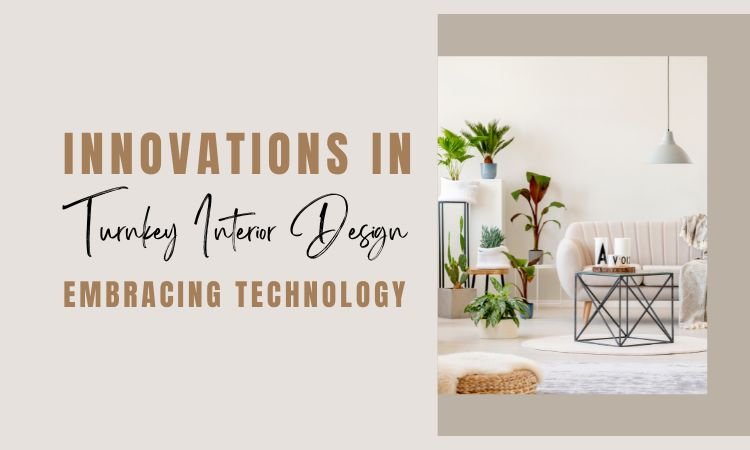The field of interior design has seen significant advancements over the years, but none as transformative as those brought about by modern technology. Turnkey interior design, where designers handle every aspect of a project from concept to completion, is leveraging these technological innovations to create more efficient, personalized, and aesthetically pleasing spaces. In this blog, we will explore some of the most groundbreaking innovations in turnkey interior design and how they are revolutionizing the industry.
The Role of Technology in Turnkey Interior Design
Turnkey interior design involves a comprehensive approach where a single provider manages the entire design and implementation process. This includes initial consultations, space planning, material selection, construction, and final installation. Integrating technology into this process enhances every step, providing benefits such as increased efficiency, precision, and customer satisfaction.
1. Virtual Reality (VR) and Augmented Reality (AR)
One of the most exciting innovations in interior design is the use of Virtual Reality (VR) and Augmented Reality (AR). These technologies allow clients to visualize their future spaces in a highly immersive way before any physical work begins.
Virtual Reality: With VR, clients can take a virtual tour of their space, experiencing the layout, colors, and furnishings as if they were physically present. This helps in making more informed decisions and reduces the risk of dissatisfaction with the final outcome.
Augmented Reality: AR apps enable clients to overlay digital elements onto their current environment. This is particularly useful for seeing how new furniture or decor will look in the existing space. It aids in selecting the right pieces and ensures that the design blends seamlessly with the current setup.
2. 3D Rendering and Modeling
3D rendering and modeling have become essential tools in turnkey interior design. These technologies allow designers to create highly detailed and realistic representations of their concepts.
3D Rendering: High-quality 3D renders provide a clear and accurate depiction of the proposed design. Clients can see how different elements will look together, from furniture and fixtures to lighting and textures. This level of detail helps in making precise adjustments before the implementation phase, saving time and resources.
3D Modeling: Designers use 3D modeling software to create accurate models of the space, considering all dimensions and proportions. This is crucial for space planning and ensuring that every piece fits perfectly within the intended layout.
3. Smart Home Integration
The rise of smart home technology is reshaping how interior designers approach turnkey projects. Integrating smart systems into the design not only enhances functionality but also adds a modern and luxurious touch to the space.
Lighting Control: Smart lighting systems allow for customizable lighting schemes that can be controlled via smartphone or voice commands. This enables clients to set the perfect ambiance for any occasion, whether it’s a cozy evening at home or a lively dinner party.
Climate Control: Smart thermostats and climate control systems ensure that the indoor environment is always comfortable. These systems can learn the user’s preferences and adjust settings automatically, improving energy efficiency.
Security Systems: Incorporating smart security systems into the design enhances safety and peace of mind. Features such as smart locks, video doorbells, and surveillance cameras can be seamlessly integrated into the design without compromising aesthetics.
4. Sustainable Design Solutions
Sustainability is a growing concern in interior design, and technology is playing a crucial role in creating eco-friendly spaces. Turnkey designers are increasingly adopting sustainable practices and materials, supported by innovative technologies.
Energy-Efficient Lighting: LED lighting and smart controls reduce energy consumption while providing high-quality illumination. Automated systems can adjust lighting based on occupancy and natural light availability, further enhancing efficiency.
Sustainable Materials: Advanced manufacturing technologies enable the production of sustainable building materials that are both durable and aesthetically pleasing. Recycled and upcycled materials are becoming more popular, reducing the environmental impact of interior design projects.
Green Building Certification: Technology aids in meeting green building standards such as LEED (Leadership in Energy and Environmental Design). Designers can use software to track and document sustainability metrics, ensuring compliance with these standards.
5. Project Management Software
Effective project management is critical in turnkey interior design, where numerous tasks and stakeholders must be coordinated. Modern project management software simplifies this process, enhancing collaboration and communication.
Task Management: These tools allow designers to break down projects into manageable tasks, assign responsibilities, and track progress. This ensures that every aspect of the project is completed on time and within budget.
Communication: Centralized communication platforms enable seamless interaction between designers, clients, contractors, and suppliers. This reduces misunderstandings and ensures that everyone is aligned with the project’s goals and timelines.
Documentation and Reporting: Project management software helps in maintaining comprehensive records of all project-related documents, including contracts, invoices, and design plans. This transparency is crucial for accountability and resolving any disputes that may arise.
Conclusion
Embracing technology in turnkey interior design is revolutionizing the industry, making it more efficient, personalized, and sustainable. From immersive VR and AR experiences to smart home integration and sustainable solutions, these innovations are enhancing the way designers create and clients experience their spaces. As technology continues to evolve, the possibilities for transforming interior design are endless, promising even more exciting developments in the future. By leveraging these technological advancements, turnkey interior designers can deliver exceptional results that meet and exceed client expectations.

